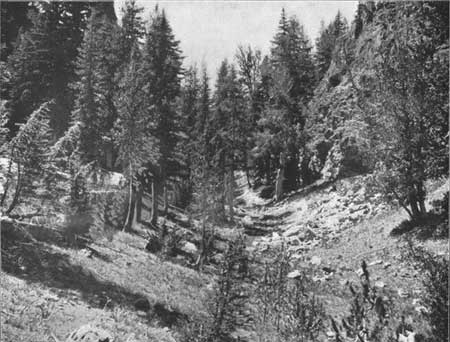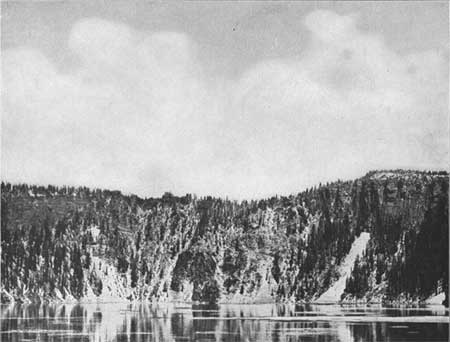The Geology and Petrography of Crater Lake National Park, 1902
PART I.
MOUNT MAZAMA.
LAVAS OF MOUNT MAZAMA.a
DACITES.
CLEETWOOD COVE DACITE FLOW.
Among the final flows of the great volcano is the one of Cleetwood Cove. The rim at this point is remarkable. It is unlike any other portion of the rim in its rugged roughness without being sharp edged like Castle Crest. It is wooded with small pines and firs, but the bold crags stand out among them in pinnacled relief. The lava is a black, yellow, or brown glass, and is greatly broken and rough on the top. It forms the crest of the rim for nearly a mile, extending upon both sides of Cleetwood Cove, where it makes prominent cliffs. It fills an old valley at the head of the cove, and has a thickness of over 300 feet in the middle, tapering to a thin edge on both sides. Pl. X, B, illustrates its appearance from the lake. This broad flow extends from the rim northeastward for nearly 3 miles, where it disappears beneath the plain of pumice and glacial material. The bottom of andesite on which the dacite rests is irregular, and in places the two rocks are separated by a thick layer of pumice.
Plate X.—A. VALLEY OF CAVED-IN TUNNEL.
Plate X.—B. CLEETWOOD COVE FLOW.
On tracing the rugged mass of dacite away from the lake there is found upon its surface a small valley (Pl. X, A) lined with cliffs and local columns. The valley is nearly as deep as wide. Huge blocks of dacite have tumbled about in the most irregular manner, producing small inclosed basins. The valley is not a waterway, and judging from its peculiarities it is altogether probable that it is a caved-in lava tunnel.
Upon both sides of the surface the dacite is flattish and looks glaciated, yet no certain glacial marks could be found, although large fragments regarded as bowlders were seen resting upon it. West of the chaotic channel and also on the east above the cliff there appears to be some morainic material. Close to the crest at the head of Cleetwood Cove the surface is most broken and rugged. A little farther west the flow thins rapidly, forming West Deer Cliff, and runs out near the next point.
The upper portion of the sides of Cleetwood Cove is a cliff of dacite, beneath which there is a layer of pumice, succeeded downward by 350 or more feet of exposed andesitic flows. These subdacite lavas are continuous around the head of the cove, but are not exposed. At the head of the cove they are covered by dacite which flowed down the inner slope of the rim from the caved-in tunnel of Rugged Crest to the lake.
The flow is wide above and narrow below, lapping down over the edges of the andesite into the lake. How far it extends beneath the surface of the lake is unknown, but apparently only a short distance.
Some distance above the lake, upon both sides, the flow and platy structure of the dacite overlying andesite dip toward the central stream, which in places dips toward the lake at an angle of 35° and lies parallel to the present surface. The structure inclined toward the lake is very clear, and its parallelism to the surface underneath well exposed upon both sides. Near the summit the glassy rock (111) is red and black, and may be mixed with gray. Nearly midway from summit to lake, where the slope is steepest, the lava (112) is somewhat less glassy than near the crest, and near the lake (113) the crystalline structure is still more marked.



